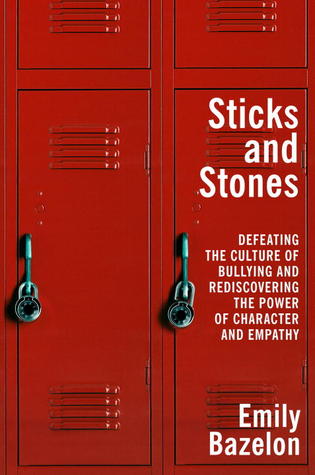First published in the April 2013 issue of East Side Monthly.
Until fairly recently, I have not spent a lot of time thinking about bullying at our neighborhood schools. While I don’t believe that the East Side is a magical conflict-free zone, and I have certainly heard about bullying incidents in school buildings, on school buses and other settings, neither do I think that bullying poses a virulent threat to our neighborhood. Nevertheless, my work (as director of publications and communications for Educators for Social Responsibility, a nonprofit that works with schools to improve school climate and culture and academic success for all learners) has opened my eyes to persistent prevalence of bullying and prompted me to better understand the ways that we (all of us who work and coexist with young people) need to take responsibility by moving from passive bystanders to active allies.
 Sticks and Stones: Defeating the Culture of Bullying and Rediscovering the Power of Character and Empathy is a fantastic resource that has informed me as I’ve gotten my thoughts organized about what adults need to do about creating safer environments for children. Author Emily Bazelon reports that bullying is verbal or physical aggression repeated over time involving a power differential between aggressor and victim. Bullying doesn’t describe the relationships of rivals, however contentious they may be, nor does it describe isolated violent incidents, however distressing they may be.
Sticks and Stones: Defeating the Culture of Bullying and Rediscovering the Power of Character and Empathy is a fantastic resource that has informed me as I’ve gotten my thoughts organized about what adults need to do about creating safer environments for children. Author Emily Bazelon reports that bullying is verbal or physical aggression repeated over time involving a power differential between aggressor and victim. Bullying doesn’t describe the relationships of rivals, however contentious they may be, nor does it describe isolated violent incidents, however distressing they may be.
Statewide school survey data reported in 2012 by Rhode Island Data Hub indicate that 57% of public school students in grades four through 12 report that they have experienced some form of bullying; as far as I am aware, no such statistics are available for independent schools. (If you wish to know the sorts of bullying students reported and the data for specific schools, you can dig into the report; click on Reports, and enter bully into the search box.) While the specific experiences that Rhode Island students reported may be somewhat broader than Bazelon’s bullying definition, the prevalence of such experiences shocked me.
So what are we to do? In Sticks and Stones, which dives into specific cases of bullying and harassment, including cyberbullying, Bazelon explores solutions and recommends that we have collective responsibility for our own communities.
Schools, as the main institutions that impact the lives of children, clearly play a role. In 2012, the Providence Public Schools launched a campaign that took a stand against bullying and offered some educational components. The campaign likely helped raise awareness among adults. This is critical, because bullying is worse in schools where students don’t think that adults are listening and responsive. Schools that support good behavior and implement strategies for addressing persistently challenged and challenging students tend to see a reduction of bullying. Some of our city’s schools are working on implementing such measures and all must find ways to do so effectively.
At the same time, we cannot expect schools to be the only source of solutions for bullying or for any of the other difficulties that young people face. Many forms and instances of bullying, particularly cyberbullying, happen outside of school. Sticks and Stones offers compelling analysis of adolescent cyberbullying and its potentially devastating impact. Online taunting, accusations and threats spread easily and are often difficult to delete. What happens online does not stay online; it follows young people to school and through time. Bazelon argues that Facebook and other social media outlets must do more to collaborate with schools and families to educate their younger users and keep them safe.
Those of us who are parents must take primary responsibility for our children’s wellbeing. As this relates to bullying, it means both protecting them and helping them build resilience. Though statistics tell us that many of our children will neither be aggressors nor victims, some of us will need to face this with our kids. Our best move is to help them become empathetic so they will not become bullies and to build character to help them navigate difficult situations. Both empathy and character will also help them stand up for their peers who are being bullied.
Most of all, we need to communicate well. In whatever ways make sense for us, we need to keep the channels open so we can listen to what’s happening in our kids’ lives. Asking questions, paying attention, and getting help when needed can make all of the difference. Because their worlds can be rough, be a safe haven for the kids in your life.








